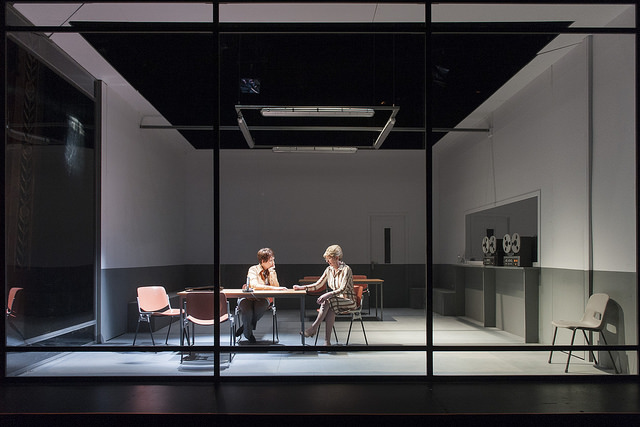@ Citizens Theatre, Glasgow, until Sat 30 May 2015
Robert David MacDonald’s gripping adaptation of Gitta Sereny’s study of evil, Into That Darkness, condenses her 60-hour interview with Franz Stangl into two hours of meticulously chosen scenes. Gareth Nicholls’ production and intricate analyses of these key moments highlight how easily evil can come into existence and how we may be closer to it than we think.
Cliff Burnett plays the convicted Nazi war criminal, Stangl, who oversaw the deaths of nearly 1 million people during World War II. The commandant spends a gruelling two hours attempting to explain his complicity in the atrocities to Sereny, played by Blythe Duff, who sought to evaluate how this ordinary man could rationalise the genocide that he helped to conduct. With his hair slicked back, waistcoat fastened and tie pulled tightly to his neck, he initially exudes a cold and austere demeanour. However, Burnett’s continually twitching hands, often restrained behind his back, offer a true sign of the horrors he has seen – a hint at his guilty conscience – and it is not long before the cracks in his psyche begin to transpire.
Audience members are given no time to settle into the theatre on entering pre-performance. With jackets still half on, in the midst of assessing the Perspex cube that encloses Neil Haynes’s interrogation room set, blinding lights startle attendees into their seats. Stuart Jenkins’ harsh lighting between scenes, along with the loud, screeching rumble that resembles a tape recorder ending, causes disorientation and discomfort. We begin to anticipate their return each time the lights cut out, but still catch ourselves jumping with comical fright each time they do, adding to the unsettling feeling that the content of Burnett’s extended monologues bring.
Burnett offers a magnificently accurate portrayal of this proud, but quickly fraying man, becoming slightly weaker and scruffier each time the lights come back up. The removal of his jacket, the unbuttoning of waistcoat, the eventual removal of tie, mark his rapid deterioration. Despite such wordy documentary material, Nicholls holds his audience captive for the plays entirety through content, acting performances and his own theatrical direction. As the final lights beam into the audience, showing us a distorted reflection of ourselves in the walls of the interrogation room, we are left with the disturbing question of what we would have done in Stangl’s position. Nicholls uses the set as a mirror, suggesting that people like us are capable of evil. Evil becomes the everyday in this contemplative examination of human cruelty.
